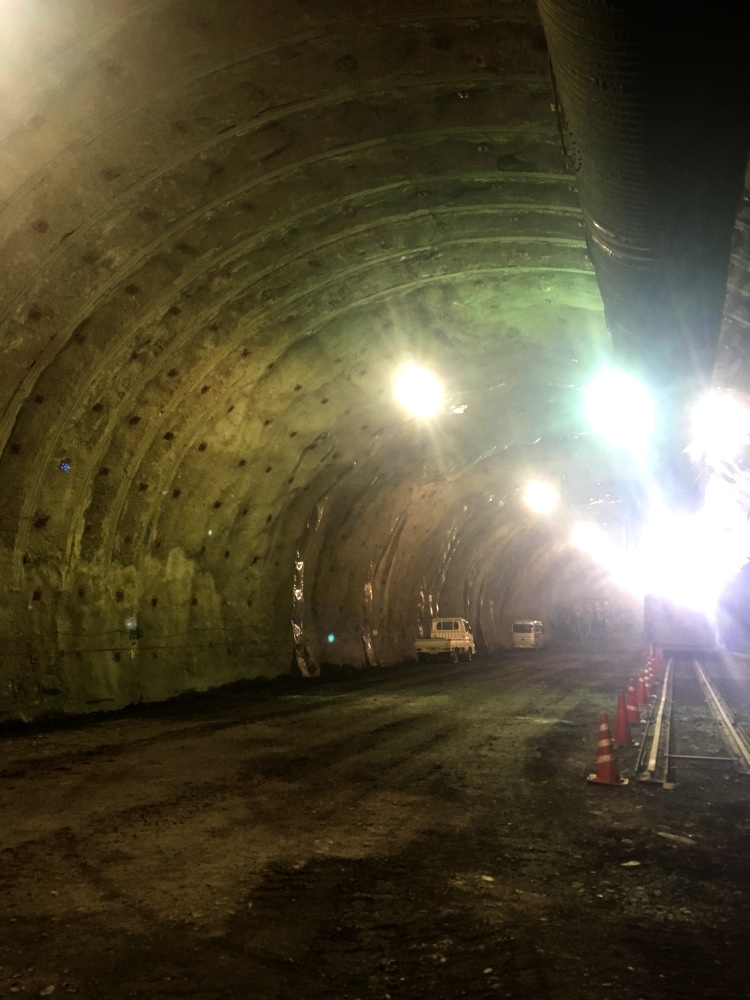We tend to take the tunnel for the ILC for granted. The current focus is on getting the national government to make a move on the ILC, and getting the people of Japan to support the project. The actual physical tunnel in the Kitakami mountains is just the details. But when you think about it, this huge tunnel would actually be quite a feat! For reference, the Seikan Tunnel underneath the sea between Aomori and Hokkaido is almost 54 km long, and the longest tunnel in Japan. The ILC may be built as long as 50 km, so technical experience in digging tunnels is going to be crucial.
Well, you’re in luck – We actually got to see a tunnel in progress right now in Iwate that gives a good picture of how the gargantuan ILC tunnel will be created.
The Shin-Kuzakai Tunnel
As part of the reconstruction from the 2011 earthquake and tsunami, the national government has been building “reconstruction roads,” which are highways that connect the inland to the coastal regions. In Iwate, there is an East-West Highway being built between Morioka City inland, and coastal Miyako City. However, there’s a big issue with building high-speed throughways in Iwate: you need to burrow through the countless hills and mountains in our central region. For this particular highway, Kajima and Tokyu Joint Venture received a contract from the national government to build a 5km long tunnel called the Shin-Kuzakai tunnel, which will be the longest tunnel in Iwate.
(until the ILC, that is!)
One challenge following the 3.11 earthquake and tsunami was in traveling quickly to the coastal regions. When the East-West Highway between Morioka and Miyako is finished, not only will it be used as a route for quickly supplying disaster aid and reconstruction equipment, it will also improve emergency medical care, promote tourism, distribution, and other industries, and increase exchange between regions through more convenient travel.
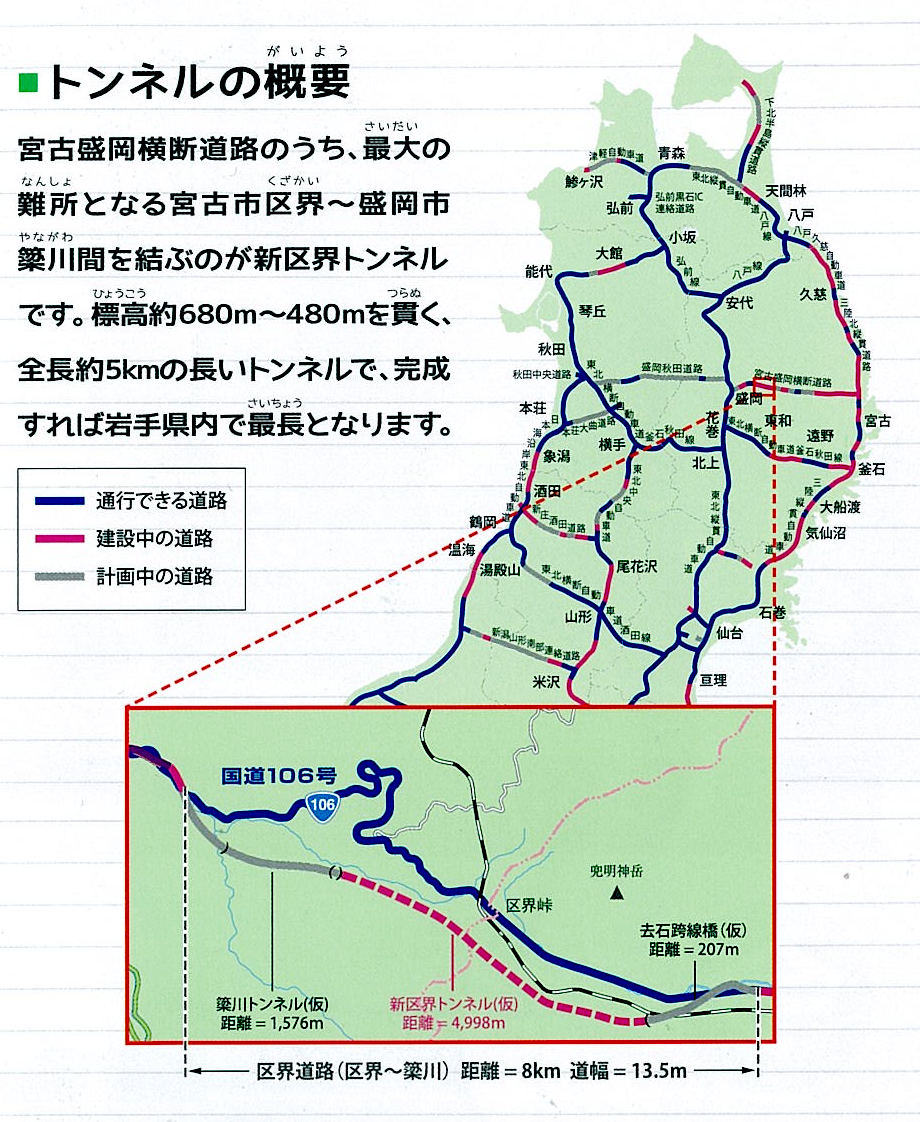
Map of Tohoku and the section of the Shin-Kuzakai Tunnel in Iwate.
(Courtesy of Kajima and Tokyu Joint Venture)
Techniques used at Shin-Kuzakai Tunnel
Kajima and Tokyu Joint Venture, the company responsible for building the tunnel, has been using a drill jumbo machine from Sweden that helps them dig the tunnel. They’re using the New Austrian Tunneling Method (NATM), which makes the most of the strength of the rock mass surrounding the tunnel (the most common method used in Japan since its introduction forty years ago).
Shotcrete and rock bolts (and steel support, if necessary) are used immediately after the excavation to prevent the rock mass from loosening, whereas wooden logging and steel support were used in the Japanese conventional tunnel method from 30-40 years ago. Compared to the TBM (Tunnel Boring Machine) method, the NATM has a number of advantages, such as creating complicated tunnel cross sections more easily.
This fully-automatic computer jumbo is quite advanced – it only needs one person at the helm while its four mechanical arms drill holes and inserts bolts, all guided by its computer system.
The Process:
 The machine drills holes and miners insert explosives, which then blasts away the rock.
The machine drills holes and miners insert explosives, which then blasts away the rock.- Trucks transport the muck outside of the tunnel.
- Shotcrete (sprayed concrete) is applied onto the tunnel walls, and then reinforced with rock bolts.
- The tunnel walls are finished with more concrete using traveling forms.
(Courtesy of Kajima and Tokyu Joint Venture)
Prof. Masakazu Yoshioka, professor at KEK and visiting professor at Tohoku University and Iwate University, said that the NATM method would likely be used for the ILC tunnel. By then, there may be even safer and more cost-effective methods available.
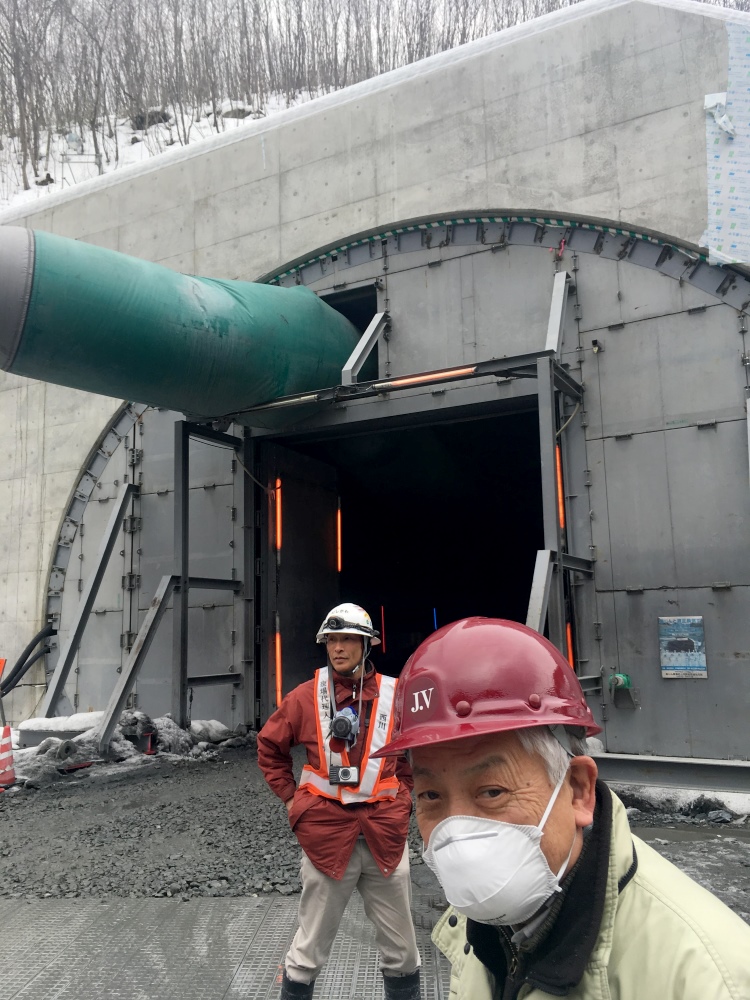
Prof. Yoshioka appraises the tunnel
Global human resources
But why go to all the trouble of using a jumbo from abroad? “We thought we should apply new, great technology to improve our productivity, regardless of where it comes from,” said Yu Koizumi, a civil engineer on this project (and also a phenomenal speaker of English). “This machine would work even better on the comparatively harder granite layers at the ILC candidate site in the Kitakami mountains.”
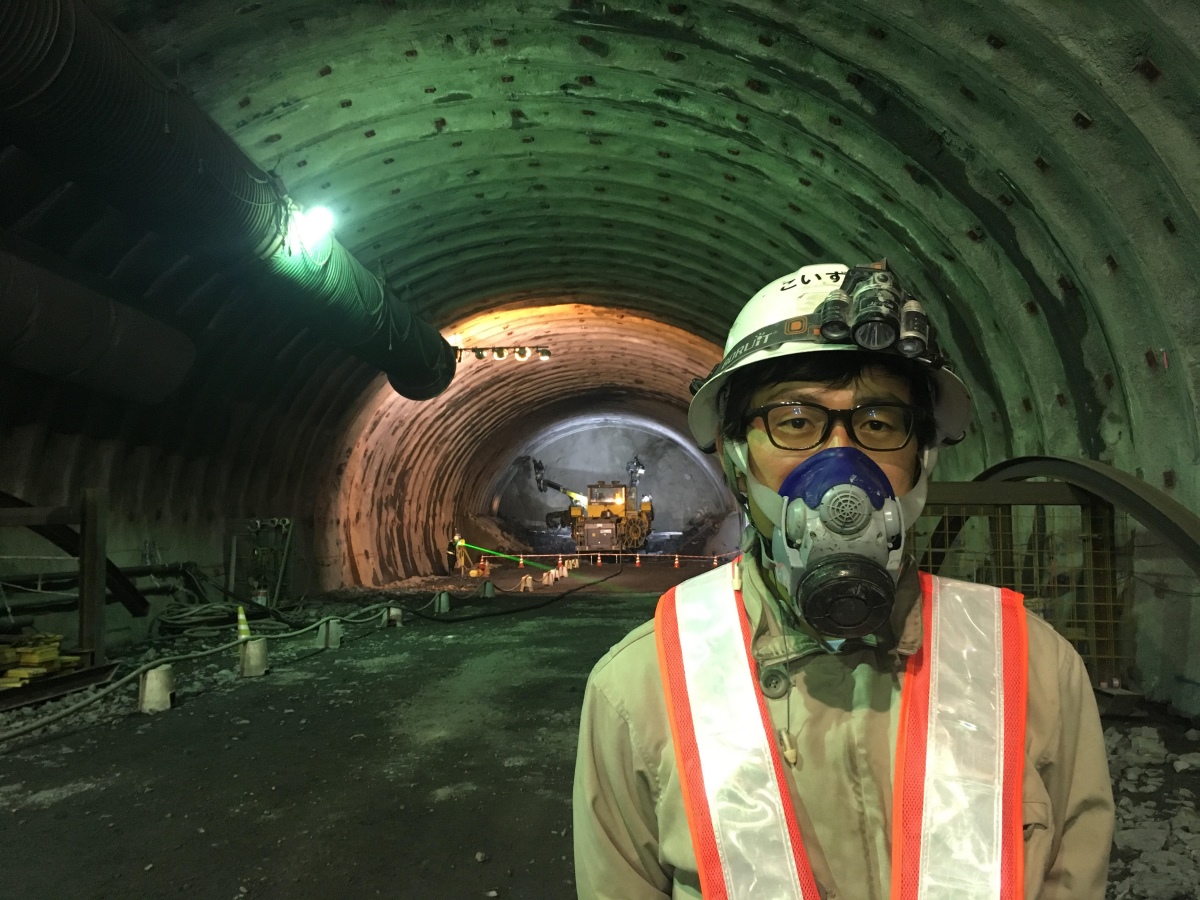
Civil engineer Mr. Yu Koizumi in front of the jumbo
Mr. Koizumi has studied at the Colorado School of Mines in the USA, which specializes in geosciences and engineering. His experience abroad has gotten him excited about the possibilities of the ILC and will surely serve him well in the future. “I’d love to be involved with the ILC construction, and we are ready to construct great tunnels for the ILC,” he said. “I’m not originally from Tohoku, but my family and I think it’s a very nice place to live. Please come to Iwate from all over the world to make this place a leader in science!”
As we continue working to bring about the ILC, at least we know there is plenty of knowledge about creating the tunnel that will be its home.
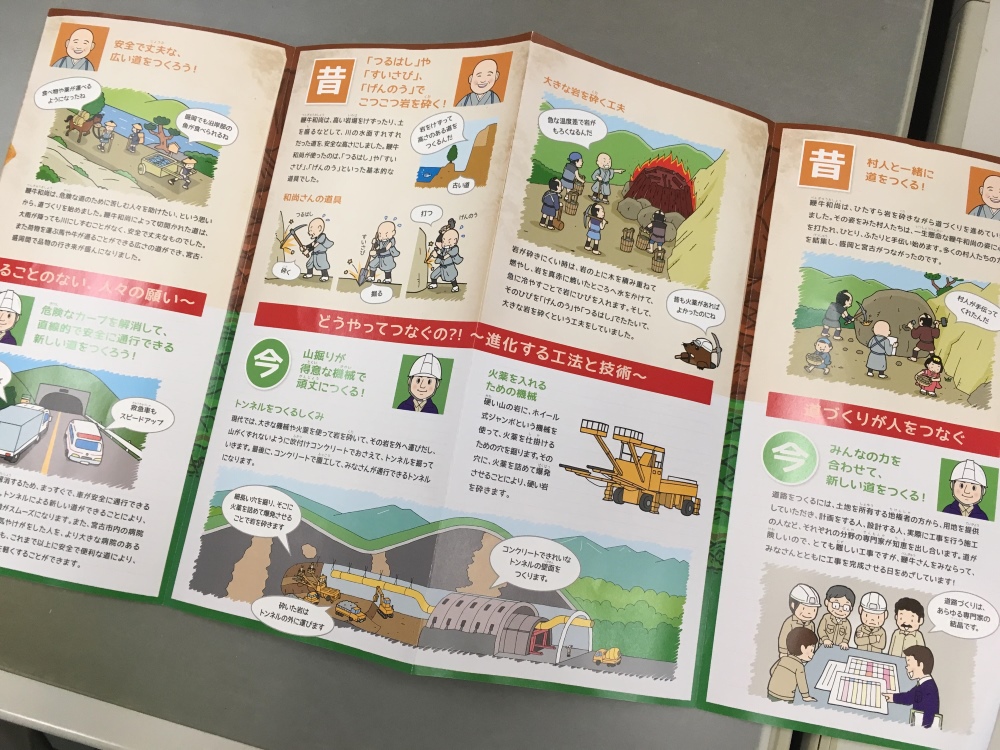
The Shin-Kuzakai tunnel project pamphlet, showing the difference between tunnels made in the past vs. today. Even construction projects have cute characters in Japan! (Courtesy of Kajima and Tokyu Joint Venture)
Japanese
ILCトンネル建設に向けて岩手の内陸部で建設中の「新区界トンネル」について
和山アマンダ
ILC計画を進める中で、トンネル工事は当たり前のことだと思う傾向があります。現在、政府のILC誘致の早期決定への働きかけや国民理解の増進を中心に取り組んでいるため、北上山地に実際に建設されるトンネル工事はあまり注目されていないのが現状です。しかし、考えてみれば、ILCの巨大なトンネルを掘るということは、実に大変な仕事です。その参考になるのが、北海道と青森を海底で結ぶ全長約54キロメートルの、日本最長の青函トンネルですが、ILCのトンネルは最長50キロメートルにまで達する可能性があり、トンネル工事のノウハウがとても重要になります。
今回、県内で建設が進められているトンネルの工事現場を視察する機会があり、ILCの巨大トンネルのイメージを掴むことができました。
新区界トンネルについて
政府は、東日本大震災津波からの復興の一環として、内陸部と沿岸部を結ぶ高規格道路「復興道路・復興支援道路」を整備しており、県内では、盛岡市と宮古市を結ぶ宮古盛岡横断道路が建設されています。この区間には、山間部が多いため、高規格道路の建設には、トンネル工事が必要不可欠です。鹿島・東急特定建設工事共同企業体は、完成すれば県内最長となる全長約5キロメートルの「新区界トンネル」の建設工事を政府から受注し、施工しています。
(岩手最長といえるのは、ILC建設までです!)
震災発生後は、沿岸部への移動が大きな課題でしたが、宮古盛岡横断道路が完成すれば、災害時の救助・救援支援のほか、救急医療環境の改善や物流や観光などの産業の振興、利便性の向上による交流人口の増加にもつながります。
【地図】
岩手県で建設が進められている新区界トンネル
(提供:鹿島・東急特定建設工事共同企業体)
新区界トンネルの建設で用いられるトンネル工法
【写真】
西川幸一所長が目指すのは「日本一安全な現場」です!
トンネルを建設している鹿島・東急特定建設工事共同企業体は、スウェーデン製の「ジャンボ」と呼ばれる機械を使ってトンネルを掘っています。この工事では、トンネル周辺地山の保持力を活用する、NATM工法(新オーストリア工法。ただし約40年前に日本に導入され、現在は日本の標準工法として定着)を採用しています。従来の矢板工法では、木製の矢板とH形鋼が使用されていましたが、NATM工法では、掘った壁面に、すぐにコンクリートを吹き付けたり、ロックボルト(必要に応じてH形鋼も)を打ち込むことで岩盤を安定させます。また、TBM工法(トンネルボーリングマシン・全断面トンネル掘進機)と比較すると、NATM工法には複数の利点があり、複雑なトンネル断面を作れたり、地質の変化に柔軟に対応できます。
スウェーデン製のジャンボは、自動化がかなり進んでおり、操縦者が一人でも、コンピュータによる自動制御で、機械の四つの「腕」を同時に操作でき、穴をあけたり、ボルトを打ち込んだりできます。
【図】
プロセス
1.ドリルで壁面に穴をあけてその中に(鉱夫が)火薬をセットし、爆破することで岩を砕きます。
2.爆破で砕いたズリ(岩石や土砂)をトンネルの外へ運び出します。
3.掘削した壁面にコンクリートを吹付け、その後、ロックボルトを壁面に打ち込みトンネルを安定させます。
4.セントル(移動式型枠)を使用して、トンネルの壁面を仕上げます。
(提供:鹿島・東急特定建設工事共同企業体)
視察に参加した高エネルギー加速器研究機構(KEK)の吉岡正和名誉教授によると、「ILCと工法が同じで参考になる。ILCの着工時にはもっといい技術でコストダウンが図られ、安全になっているだろう。」と述べました。
【写真】
吉岡先生がトンネルを評価
グローバル人材の育成
海外製のジャンボ機械を使用したきっかけについて、(英語が非常に堪能な)工事係の小泉悠氏は「優れた新技術であれば、日本製であろうと海外製であろうと採用し、生産性を高めたい」と説明してくれました。また、「ILCの建設候補地である北上山地の岩盤は、より固いため、このような機械がもっと活躍できそうだ。」と話してくれました。
【写真】
ドリルジャンボを背景に説明する工事係の小泉悠氏
小泉氏は、アメリカのコロラド鉱山大学で地質学や鉱山工学を専攻しました。海外経験が豊富で、ILC実現の可能性に期待を寄せています。「我々はILCのトンネルを建設する準備ができており、ぜひ工事に関わりたいと思っています。ちなみに、私も私の家族も東北出身ではないのですが、ここに来てとても暮らしやすいところだと感じています。世界の科学者の皆さん、ぜひ岩手にお越しいただき、岩手を最先端の科学拠点にして下さい!」
今回の視察で、トンネル工事の知識が豊富な方々が身近にいることが分かりました。引き続きILCの実現に向けて取り組んでいきます。
【写真】
昔と現代のトンネル工法の違いを分かりやすく説明した新区界トンネル工事のパンフレットです。日本では、工事の説明パンフレットにも可愛いらしいキャラクターを使っています。(提供:鹿島・東急特定建設工事共同企業体)

